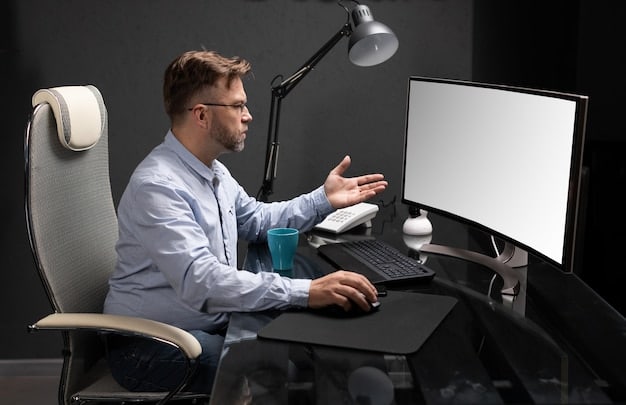Screen Time Management: Recent Updates & Eye Protection Tips

Recent updates on managing screen time and protecting eyesight emphasize balancing digital device usage with regular breaks, proper ergonomics, and adherence to the 20-20-20 rule to mitigate digital eye strain and promote overall wellness.
In today’s digital age, managing screen time is crucial for maintaining both physical and mental well-being. Recent Updates: The Latest Recommendations for Managing Screen Time and Protecting Your Eyesight often revolve around simple yet effective strategies. Discover how to safeguard your vision and overall health with these expert-backed tips.
Understanding the Impact of Screen Time on Eyesight
Excessive screen time poses various risks to your eyesight, including digital eye strain and potential long-term issues. Understanding these risks is the first step toward implementing effective management strategies. Here’s what you need to know about how screens affect your vision.
What is Digital Eye Strain?
Digital eye strain, also known as computer vision syndrome, occurs due to prolonged use of digital devices. Symptoms can include dry eyes, blurred vision, headaches, and neck pain. This condition arises from the increased focus and reduced blinking associated with screen viewing.
Long-Term Effects of Prolonged Screen Use
While digital eye strain is often temporary, consistent overexposure to screens can lead to more concerning long-term effects. These may include an increased risk of myopia (nearsightedness), particularly in children, and potential disruptions to sleep patterns due to blue light exposure.

- Dry Eyes: Reduced blinking while using screens causes eyes to dry out.
- Blurred Vision: Constant focusing strains the eye muscles.
- Headaches: Eye strain can trigger tension headaches.
- Sleep Disruption: Blue light from screens interferes with melatonin production.
Being aware of these potential impacts can inspire more conscientious screen time management, ensuring that you take proactive steps to protect your eyes and overall health.
Adopting the 20-20-20 Rule
The 20-20-20 rule is a simple yet highly effective strategy to reduce eye strain. This method encourages frequent breaks to help your eyes relax and refocus. Here’s how to incorporate this rule into your daily routine.
The Mechanics of the 20-20-20 Rule
Every 20 minutes, take a 20-second break to look at something 20 feet away. This brief pause allows your eye muscles to relax, preventing strain and fatigue. Making it a regular habit can greatly reduce the symptoms of digital eye strain.
Tools and Reminders to Stay Consistent
To ensure you consistently follow the 20-20-20 rule, use tools and reminders. Many apps and software programs are designed to alert you when it’s time for a break. Setting alarms on your phone or using a visual timer on your desk can also be effective.
Integrating this simple practice into your daily routine is a proactive way to care for your vision and reduce the discomfort associated with prolonged screen use.
Optimizing Your Workspace Ergonomics
Proper workspace ergonomics play a vital role in reducing strain and discomfort associated with long hours in front of a screen. Making simple adjustments to your setup can have a significant impact. Discover how to optimize your environment for better eye and overall health.
Positioning Your Monitor
Ensure your monitor is positioned at arm’s length and slightly below eye level. This placement helps minimize strain on your neck and eyes by reducing the need to constantly look up or down. Investing in an adjustable monitor stand can aid in achieving the correct height.
Adjusting Ambient Lighting
Ambient lighting should be adjusted to reduce glare on your screen. Avoid placing your monitor directly in front of a window or bright light source. Use curtains or blinds to control the light and consider adding a soft, indirect light source to reduce contrast.

- Chair Adjustment: Ensure your chair provides adequate back support.
- Keyboard Placement: Position your keyboard so your wrists are straight.
- Screen Distance: Keep a comfortable arm’s length distance from your monitor.
- Regular Breaks: Stand up and stretch every hour to alleviate overall body strain.
By focusing on ergonomic best practices, you can create a healthier and more comfortable workspace that supports both your vision and physical well-being.
The Role of Blue Light Filtering
Blue light emitted from digital devices has been a topic of concern due to its potential impact on sleep and eye health. Understanding the options for blue light filtering can help you make informed decisions about protecting your eyes. Here’s what you should consider.
Understanding Blue Light
Blue light is a high-energy light emitted by digital screens that can suppress melatonin production, disrupting sleep patterns. Additionally, prolonged exposure may contribute to eye strain and potential long-term retinal damage, though more research is ongoing in this area.
Blue Light Filtering Options
Various options are available for filtering blue light, including specialized glasses, screen filters, and built-in device settings. Blue light glasses have lenses designed to block a portion of the blue light spectrum, while screen filters can be applied directly to your device. Many smartphones, tablets, and computers also have built-in blue light filters that can be activated in the settings menu.
Utilizing these options can significantly reduce your exposure to blue light, potentially improving sleep quality and reducing eye strain.
Maintaining Proper Eye Hydration
Maintaining adequate eye hydration is essential for comfort and vision clarity, particularly when spending long hours in front of a screen. Dry eyes can lead to irritation, blurred vision, and increased discomfort. Here are some tips to help keep your eyes properly hydrated.
The Importance of Blinking
Blinking is a natural mechanism that helps keep your eyes lubricated. However, when focused on a screen, people tend to blink less frequently, leading to dryness. Consciously try to blink more often to replenish moisture in your eyes.
Using Lubricating Eye Drops
Lubricating eye drops, also known as artificial tears, can provide immediate relief for dry eyes. These drops come in various formulations, with some designed for mild dryness and others for more severe conditions. Consult with an eye care professional to determine the best option for your needs.
- Stay Hydrated: Drink plenty of water throughout the day.
- Humidify Your Environment: Use a humidifier to add moisture to the air.
- Take Breaks: Step away from the screen to give your eyes a rest.
- Warm Compresses: Apply warm compresses to stimulate tear production.
By prioritizing eye hydration, you can minimize discomfort and ensure clear, comfortable vision during prolonged screen use.
Regular Eye Exams and Professional Advice
Regular eye exams are essential for maintaining optimal eye health and detecting potential issues early. Consulting with an eye care professional can provide personalized advice and tailored solutions. Here’s why routine check-ups are crucial.
The Benefits of Routine Check-Ups
Routine eye exams can identify vision problems, such as refractive errors, as well as detect early signs of eye diseases like glaucoma and macular degeneration. Early detection and treatment can prevent vision loss and maintain long-term eye health.
Personalized Recommendations
An eye care professional can provide personalized recommendations based on your specific needs and lifestyle. They can advise on the best strategies for managing screen time, selecting appropriate eyewear, and addressing any underlying eye conditions.
Prioritizing regular eye exams is a proactive approach to safeguarding your vision. These check-ups ensure that your eyes receive the care and attention they need to stay healthy.
| Key Point | Brief Description |
|---|---|
| ⏰ 20-20-20 Rule | Every 20 minutes, look 20 feet away for 20 seconds. |
| 🖥️ Ergonomics | Optimize monitor height, lighting, and posture. |
| 💧 Hydration | Blink often and use lubricating eye drops. |
| 👓 Blue Light | Use blue light filters and specialized glasses. |
Frequently Asked Questions
▼
You should follow the 20-20-20 rule: every 20 minutes, take a 20-second break to look at something 20 feet away. This helps reduce eye strain and fatigue.
▼
Symptoms of digital eye strain include dry eyes, blurred vision, headaches, and neck pain. These symptoms are often temporary but can become chronic with prolonged screen use.
▼
Blue light glasses can help reduce the amount of blue light reaching your eyes, potentially improving sleep quality and reducing eye strain. However, effectiveness varies among individuals.
▼
Improve workspace ergonomics by positioning your monitor at arm’s length and slightly below eye level, adjusting ambient lighting to reduce glare, and ensuring your chair provides adequate back support.
▼
Regular eye exams are crucial for detecting vision problems and early signs of eye diseases. Early detection and treatment can prevent vision loss and maintain long-term eye health.
Conclusion
Managing screen time effectively is essential for maintaining eye health and overall well-being in today’s digital world. By implementing simple strategies such as the 20-20-20 rule, optimizing workspace ergonomics, and prioritizing regular eye exams, you can minimize the negative impacts of screen use and ensure long-term vision health.





